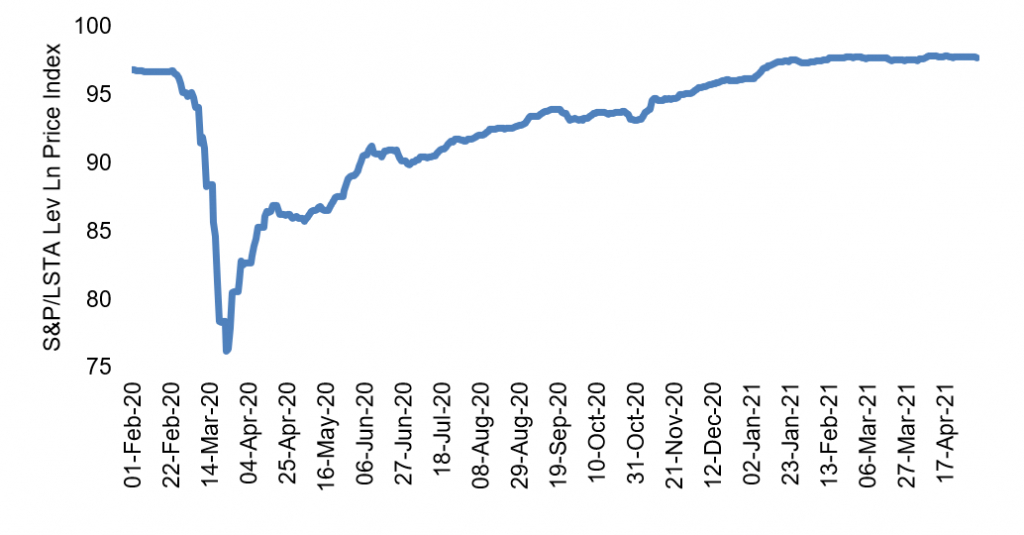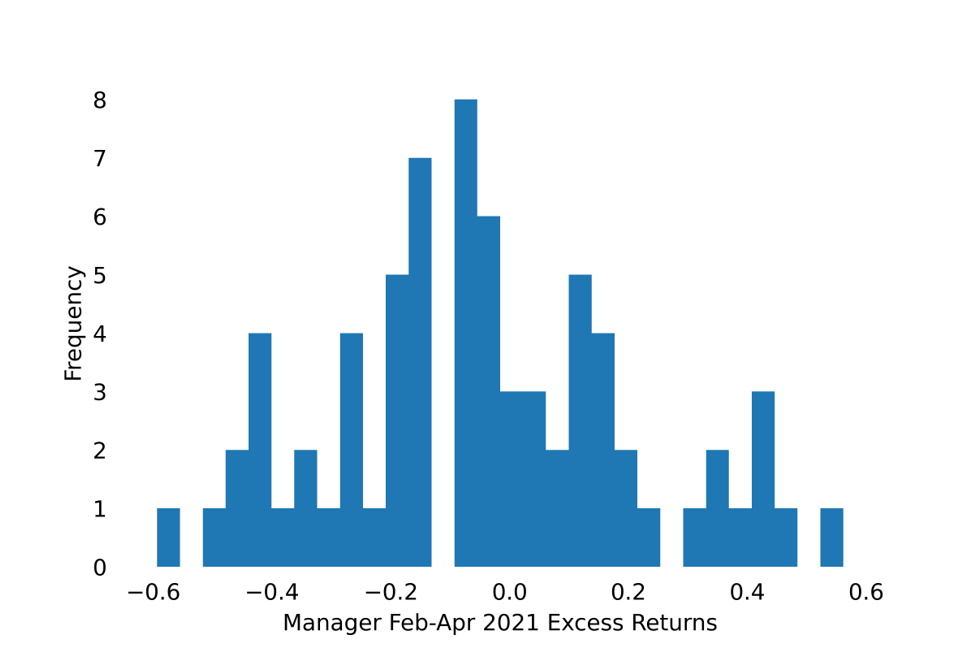By the Numbers
Risk and carry outperform through April
Steven Abrahams and Jinzhao Wang | May 7, 2021
This document is intended for institutional investors and is not subject to all of the independence and disclosure standards applicable to debt research reports prepared for retail investors.
A little more than a third of CLO loan portfolios beat the leveraged loan market from February through April. The average CLO leveraged loan portfolio gained 1.42% and, after adjusting for broad market exposure, or beta, fell behind the market by 6 bp. Aided by a recovering economy, managers who held loans with more credit, liquidity or industry risk tended to outperform their peers in the last three months.
Loan prices remained flat between February and April, continuing the plateau that began at the start of the year (Exhibit 1). The price index remains above its pre-coronavirus level. After accounting for the various reporting dates of managers, the S&P/LSTA Total Return Index gained 1.42% between February and April. Managers of five active deals or more held portfolios with an average beta of 1.04, which meant the average manager should have gained 1.47%. With the actual average performance at 1.41%, the average manager trailed the index by 0.06%.
Exhibit 1: Loan prices hover above their pre-pandemic peak by 3%

Source: Bloomberg, Amherst Pierpont Securities
About 36% of the managers finished ahead of the total return index, a small drop from the figures reported by Amherst Pierpont last month (Exhibit 2). Out of the 72 managers tracked for February through April, five delivered alpha greater than 40 bp, while eight trailed the index by at least 40 bp.
Exhibit 2: Around 36% of managers outperformed the index between February and April

Note: data shows excess return only for active deals.
Source: Amherst Pierpont Securities.
The exposure to ‘Caa1’ loans and bid depth of the portfolio correlated most strongly with recent excess returns (Exhibit 3). Managers who held loans that were less liquid or had lower ratings delivered higher returns. Additionally, lower weighted average price and wider weighted average spread correlated with more recent excess returns. Diversity of the portfolio bore little relation to their recent outperformance. Overall, managers holding riskier loans that offer more spread or yield tended to outperform.
Exhibit 3: Correlation of portfolio or manager features with recent excess return

Note: data shows the correlation of manager or loan portfolio attribute with managers’ excess return or alpha from February through April only on active deals. Portfolio attributes measured as percentiles.
Source: Amherst Pierpont Securities.
Moody’s measure of the exposure to industries with high Covid risks including hotel, gaming, and leisure also correlated highly with recent excess returns. This is in line with patterns across sector returns. The leisure industry returned 5.3% so far in 2021, while the overall S&P/LSTA leveraged loan index returned less than half of it at 2.3%. Positive news on the vaccine rollout and reopening activities contributed to the stronger rally in these sectors. As a result, managers who hold more exposure to the sectors tended to generate higher returns.
The following managers delivered positive alpha in the market between February and April (Exhibit 4). Canaras and Symphony again top the chart this time. Other Top 5 alpha leaders include Nassau, Sculptor and Seix.
Exhibit 4: Alpha leaders in CLO portfolio performance February – April 2021

Note: Performance for managers with five or more deals tracked by APS. Performance attribution starts with calculated total return on the leveraged loan portfolio held in each CLO for the 3-month reporting period ending on the indicated date. CLOs, even with a single manager platform, may vary in reporting period. The analysis matches performance in each period to performance over the identical period in the S&P/LSTA Leveraged Loan Index. Where a deal has at least 18 months of performance history since pricing and no apparent errors in cash flow data, the analysis calculates a deal beta. The deal beta is multiplied by the index return to predict deal return attributable to broad market performance. Where no beta can be calculated, the analysis uses the average beta across each manager’s active deals weighted by the average deal principal balance over time. Any difference between performance attributable to beta and actual performance is attributed to manager alpha.
Source: Amherst Pierpont Securities.


